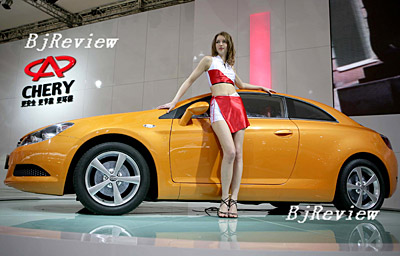
After three years of arduous negotiations, the U.S.-based Chrysler Group and Chery Automobile Co. Ltd.-the largest Chinese auto exporter-finalized their strategic cooperation agreement on July 4 in Beijing.
According to the agreement, Chery and Chrysler will partner to develop, manufacture and distribute Chery-made small and sub-compact cars in North America, Europe and other major automotive markets under the Chrysler Group brands. It could be a match made in heaven for both companies. Chery, based in Wuhu, Anhui Province, has a competitive edge in developing small, cost-efficient cars, while Chrysler has strong brand presence and marketing expertise.
Qin Lihong, sales manager with Chery, said the cooperation will be based on Chery's technology and models. He disclosed that Chery would develop five models while Chrysler would contribute one or two. After this, the two companies will cooperate on developing future lines of cars.
The first model is a Dodge, which is based on Chery's 1.3-liter A1 notchback and will be sold at about $10,000. The first batch of the cars will be ready to ship to Mexico before January next year. Other models will be exported to the United States in 2009, though details of these designs have not been released.
Supervision over production, manufacturing and development is to be conducted by Chrysler in order to ensure that the made-in-China Chrysler complies with Chrysler's international quality standards. Steven Landry, Executive Vice President of Chrysler in charge of global sales, confirmed that Chrysler will dispatch more of its engineers to China to oversee research and development.
Global market checkered flag
As a leading auto exporter in China, Chery has continually explored overseas markets, and because of this its global sales have increased rapidly. In 2005 Chery exported 18,000 vehicles, and the number grew to more than 50,000 in 2006. Chery's 2007 goal was to export 70,000 vehicles by the end of the year. Due to the success of exports in the first half, the number of exports for this year is expected to surpass the previous goal and approach 100,000, a number that would account for one quarter of all Chinese vehicle exports.
In order to secure more profits in the global market, Chinese automakers are trying to enter the lucrative European and North American markets, instead of focusing on current favorites in the Middle East and Southeast Asia. There have been difficulties entering these more mature markets due to technological obstacles connected to energy conservation, environmental protection and safety issues, as well as non-tariff barriers like sales, logistics and legalities.
With this as the backdrop, the cooperation between Chery and Chrysler has created a new model for Chinese automakers wishing to enter the European and American markets-the model of combining comparative advantages and international resources. At the signing ceremony, Yin Tongyao, President of Chery, repeatedly stated that Chery should learn more from Chrysler.
Yin said this cooperation is meant to avoid the previous setbacks of other countries in entering the markets of developed countries. Even Japanese cars once lost their U.S. market due to their failure to suit the local consumers' needs, and Hyundai from South Korea faced security problems getting into the U.S. market. Chinese brands Landwind and Brilliance, for example, were unable to enter the European market because of their failure to meet NCAP crash test standards, creating a lasting negative image for Chinese automobiles.
Yin said that Chery's cooperative effort will help them better understand the U.S. market and its rules and regulations, something that will eventually help his company break into the European market. This cooperation is also expected to promote Chery's localization effort from the very beginning. Toyota in Japan has set a good example in this regard. In order to make its way further into the U.S. market, the Japanese automaker once initiated cooperation with General Motors in the United States.
Turbo boost for Chrysler
Chrysler isn't in this for nothing. The 80-year old U.S. car manufacturer is the third largest in the United States, with its sales exceeding 2 million units last year.
However, it suffered losses of $1.5 billion that year and was sold to a U.S. private equity firm Cerberus at $7.4 billion, five times less than the price of $38.33 billion offered by Daimler-Benz 10 years ago.
Although Chrysler is strong in manufacturing, it is weak in car line arrangements. Among Chrysler lines, sport utility vehicles, pickups and small vans-which are high-energy consumers-comprise a major part. With increasing oil prices, small cars have become the first choice for many consumers around the world. More U.S. consumers are also switching their attention to small cars.
But the Chrysler Group cannot invest huge amounts to develop their own small cars. Even if they wanted to, the high costs of human resources would make these types of cars less competitive in the United States than Japanese cars. Chrysler was wise to choose Chery: on the one hand, Chrysler can make the best use of its own designing ability, and on the other, the Chinese manufactured Chery will help cut costs and reduce the research and development cycle for Chrysler.
"This is the start of a very long relationship between Chrysler and Chery," said Tom LaSorda, Chrysler Group President and CEO. "Chery's participation in this agreement and their focus on small and sub-compact cars will have a nearly immediate effect on Chrysler Group's offerings in the small-vehicle segment."
Chrysler intends to integrate Chery into its global small car strategy and has promised to build Chery into its small car manufacturing platform.
"This strategic partnership is part of a new business model that is allowing us to introduce all-new products more quickly, with less capital spending," said LaSorda. | 